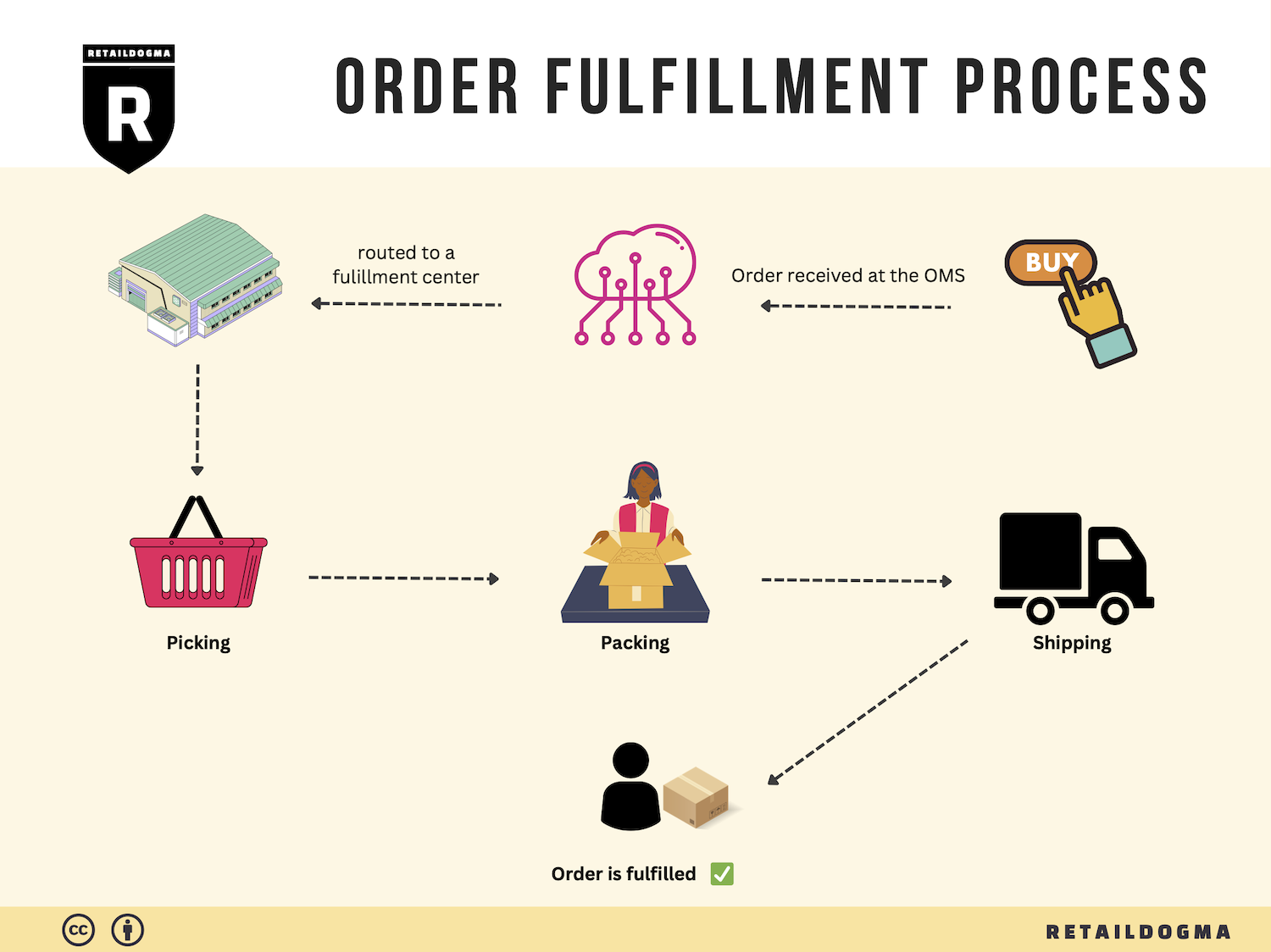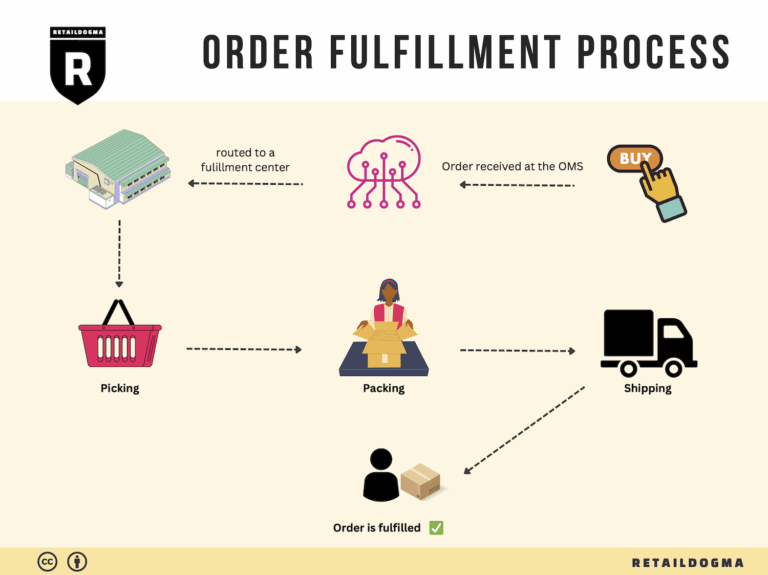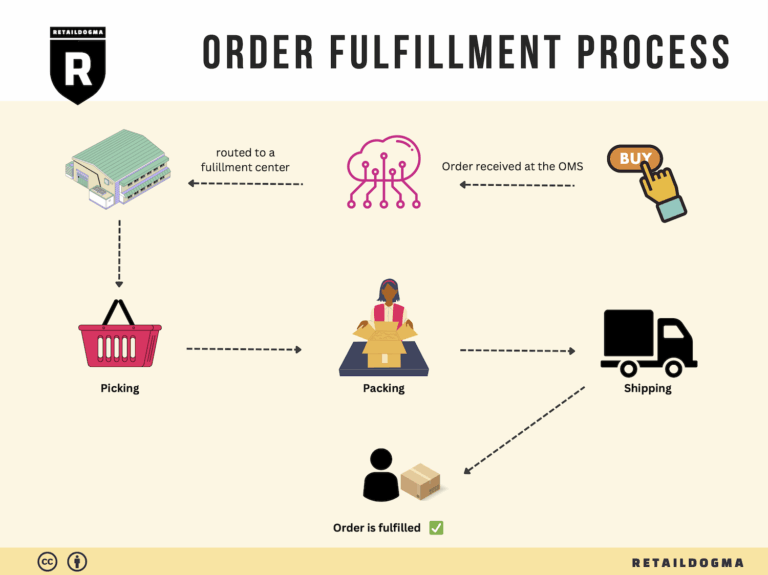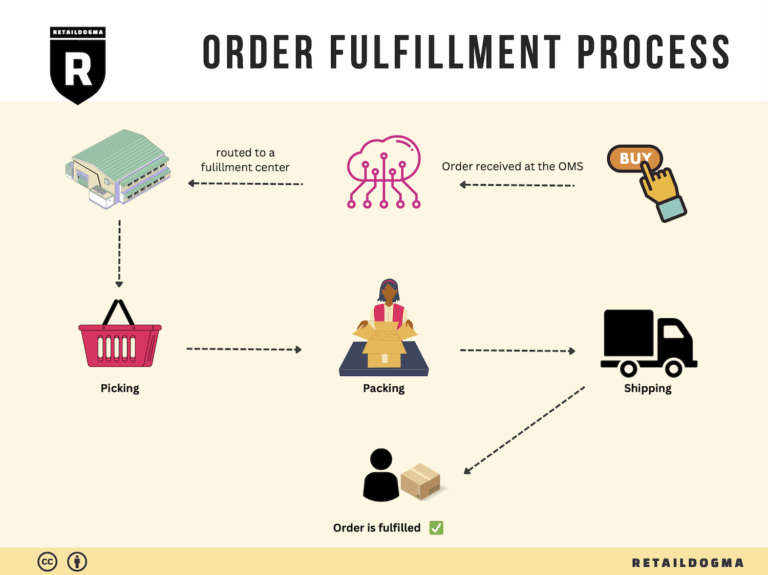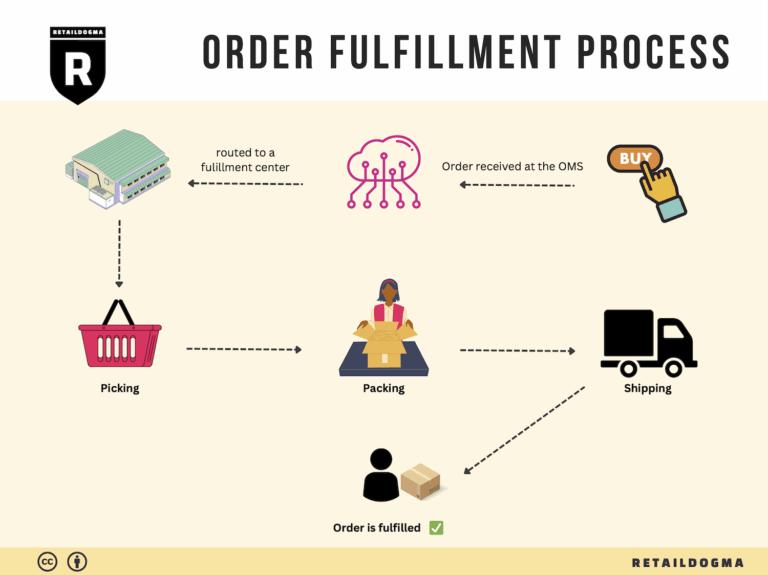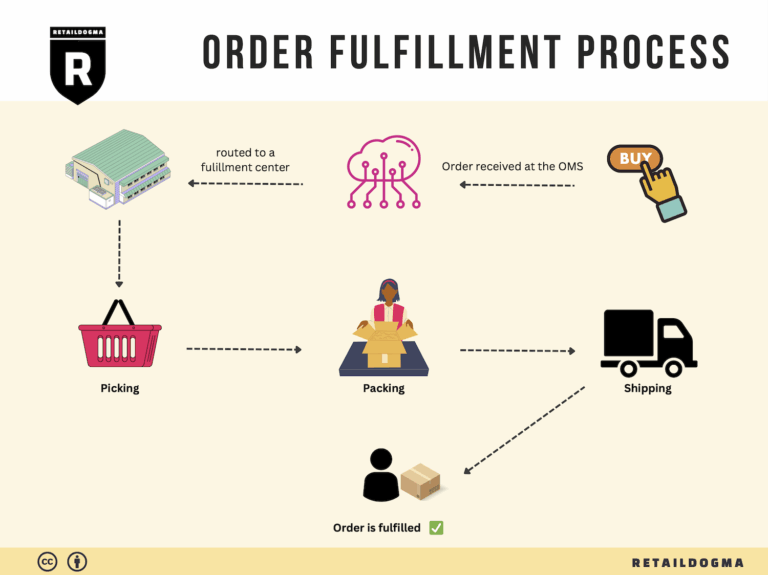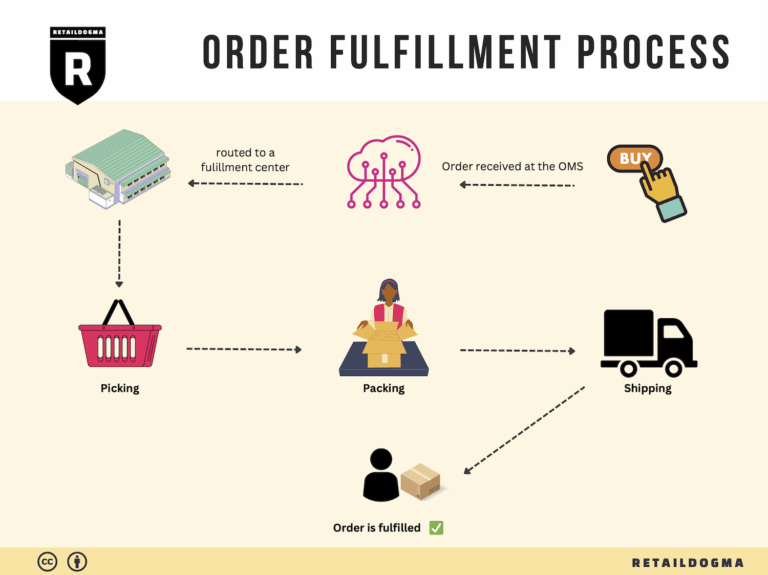Ecommerce Fulfillment Services: The Ultimate Guide (2025)
What is E-commerce Fulfillment? An Introduction for Growing Businesses
As an e-commerce business owner, you might find yourself grappling with a common pain point: the overwhelming task of packing and shipping orders. The excitement of growing sales can quickly turn into stress when faced with the logistics of fulfilling those orders efficiently and accurately. This is where e-commerce fulfillment comes into play, serving as a vital link between your business and your customers. Simply put, fulfillment is the process of getting a product from your warehouse or supplier to your customer’s doorstep.
In the rapidly evolving world of online retail, understanding the nuances of fulfillment can be a game-changer for your business. This guide aims to demystify the various fulfillment models available to you, such as Third-Party Logistics (3PL) and Fulfillment by Amazon (FBA). Each model has its advantages and considerations, and knowing the right fit for your business is crucial as you scale.
We will explore the core services included in e-commerce fulfillment, which range from inventory management to order processing, packing, and shipping. Additionally, we will discuss the importance of selecting the right fulfillment partner. The right choice can not only improve your operational efficiency but also enhance customer satisfaction. Factors to consider when choosing a partner include their location, technology capabilities, scalability, and track record in handling your specific product types.
Pricing is another critical aspect that we will cover. Understanding the cost structure associated with various fulfillment options will empower you to make informed financial decisions. From storage fees to shipping costs, having a clear grasp of these elements will help you budget effectively and optimize your profit margins.
The ultimate goal of this guide is to empower you with the knowledge needed to make smart, strategic decisions about your logistics. By streamlining your fulfillment processes, you can focus on what you do best: growing your business and delivering exceptional value to your customers. As you navigate the complexities of e-commerce fulfillment, this guide will serve as a comprehensive resource to help you achieve operational excellence and sustained growth.

What You’ll Learn In This Guide
- What is E-commerce Fulfillment? An Introduction for Growing Businesses
- The Order Fulfillment Process: From ‘Buy’ Button to Customer’s Door
- Comparing Fulfillment Models: In-House vs. 3PL vs. Dropshipping
- A Deep Dive into Amazon FBA: Pros, Cons, and Who It’s For
- Core Services Offered by Fulfillment Centers
- How to Choose a Fulfillment Partner: A 6-Point Checklist
- Understanding Fulfillment Pricing: A Breakdown of Common Fees
- Frequently Asked Questions (FAQs) about Fulfillment
- Conclusion: Is Outsourcing Fulfillment the Right Move for Your Business?
- Important Disclaimer
The Order Fulfillment Process: From ‘Buy’ Button to Customer’s Door
1. Receiving Inventory
The order fulfillment process begins with receiving inventory. This step involves accepting shipments of products from suppliers and manufacturers. Upon arrival, the inventory is checked against purchase orders to ensure accuracy in terms of quantity and quality. This verification process is crucial for maintaining accurate stock levels and preventing discrepancies that could lead to stockouts or overstock situations.
A key term associated with this step is SKU (Stock Keeping Unit). Each product is assigned a unique SKU, which aids in tracking and managing inventory throughout the fulfillment process. Proper inventory management at this stage lays the foundation for efficient operations, ensuring that the right products are available when orders are placed.
2. Warehouse Storage
After inventory is received and verified, the next step is warehouse storage. This involves strategically placing products within the warehouse to optimize space and accessibility. Proper storage methods can significantly enhance the speed and efficiency of subsequent steps in the fulfillment process.
Effective warehouse organization relies on various strategies, such as zone storage and ABC analysis. Zone storage involves dividing the warehouse into specific areas based on product characteristics, while ABC analysis categorizes inventory based on sales volume and turnover rates. By utilizing these methods, businesses can streamline the picking process, reduce retrieval times, and minimize the risk of errors during order fulfillment.
3. Order Picking
Once a customer places an order, the next step is order picking. This process involves retrieving the correct items from their storage locations based on a pick list, which details the SKUs and quantities needed for each order. Efficient order picking is vital for maintaining customer satisfaction, as it directly impacts delivery speed and accuracy.
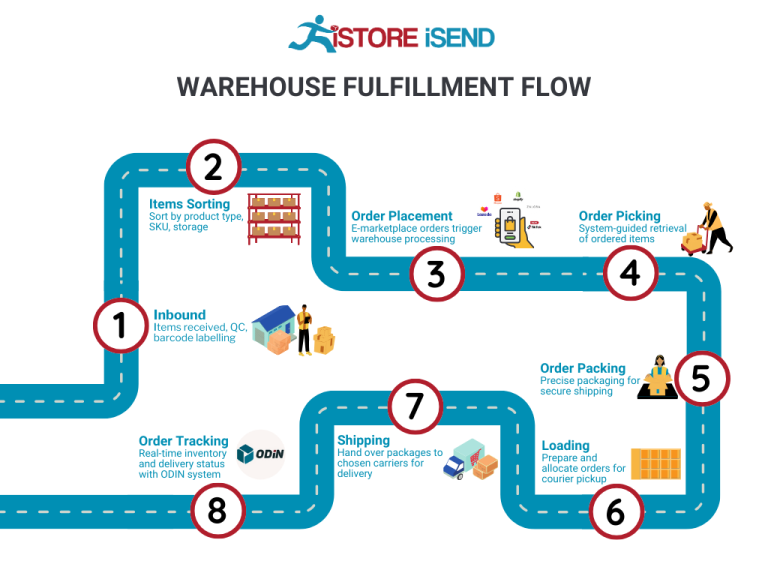
A pick list is a critical tool in this step, as it guides warehouse staff to the correct locations within the facility. There are various picking methods, such as single order picking, where one order is fulfilled at a time, and batch picking, which allows multiple orders to be picked simultaneously. Implementing the right picking strategy can significantly enhance productivity, reduce labor costs, and improve order accuracy.
4. Order Packing
After the items have been picked, they move to the order packing stage. This step involves assembling the selected products into a shipment-ready package. Proper packing is essential for protecting items during transit and ensuring they arrive in perfect condition.
Key considerations during the packing process include selecting the appropriate packaging materials and including necessary documentation, such as packing slips and invoices. The term packaging optimization comes into play here, as it refers to using the right materials and techniques to minimize shipping costs while ensuring product safety. Effective packing not only reduces the risk of damage but also enhances the overall customer experience by presenting a well-prepared order.
5. Shipping & Delivery
The final step in the order fulfillment process is shipping and delivery. Once orders are packed, they are labeled and prepared for transportation to customers. This step involves selecting appropriate shipping carriers and methods based on factors such as cost, delivery speed, and destination.
A key term in this phase is last-mile delivery, which refers to the final leg of the shipping journey, where packages are delivered from a transportation hub to the customer’s doorstep. Efficient last-mile delivery is critical for ensuring customer satisfaction and can be a significant factor in a business’s overall logistics strategy. By optimizing shipping routes and leveraging technology, such as real-time tracking systems, businesses can improve delivery times and enhance the customer experience.
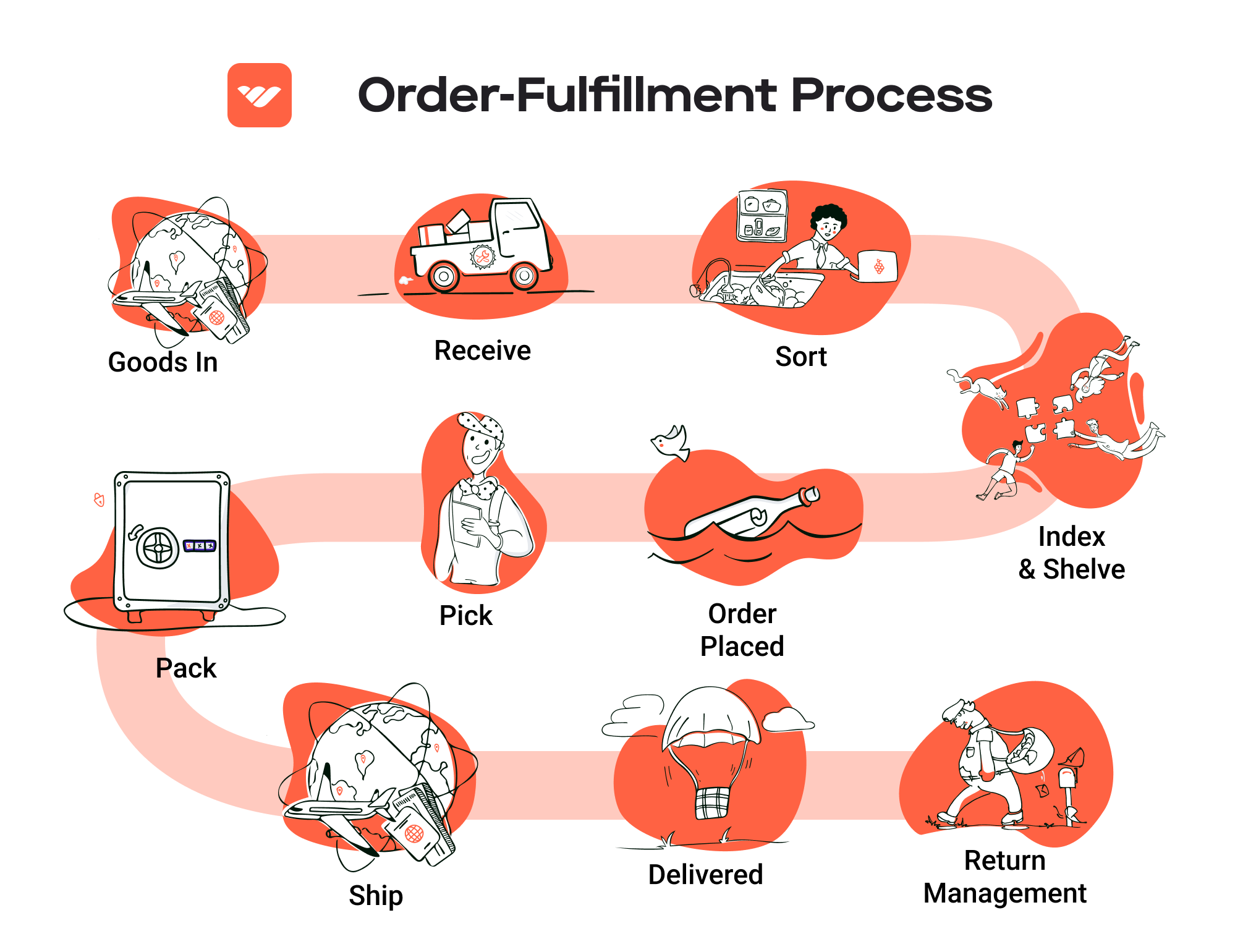
In conclusion, understanding and optimizing each step of the order fulfillment process—from receiving inventory to shipping and delivery—can significantly impact a business’s operational efficiency and customer satisfaction. By implementing best practices and utilizing the right tools and strategies at each stage, e-commerce businesses can scale their operations effectively while ensuring a seamless experience for their customers.
Comparing Fulfillment Models: In-House vs. 3PL vs. Dropshipping
Comparison of Fulfillment Models
| Model | Who Handles Inventory | Best For (Business Stage) | Key Advantage | Key Disadvantage |
|---|---|---|---|---|
| In-House Fulfillment | The business itself | Established businesses with stable demand | Full control over inventory and processes | High overhead costs and complexity |
| Third-Party Logistics (3PL) | A third-party logistics provider | Growing businesses and startups | Scalable, flexible, and often lower costs | Less control over inventory and processes |
| Dropshipping | Supplier or manufacturer | Startups and small businesses | Low upfront investment and risk | Lower profit margins and longer shipping times |
In-House Fulfillment
In-house fulfillment involves a business managing its own inventory, warehousing, and shipping processes. This model is best suited for established businesses with a stable demand for their products. One of the primary advantages of in-house fulfillment is the complete control it offers over inventory management and order fulfillment processes. Businesses can tailor their storage and shipping strategies to meet customer expectations, ensuring quality and service consistency. Additionally, this model allows for immediate adjustments based on customer feedback or market trends, which can enhance responsiveness and customer satisfaction.
However, managing an in-house fulfillment operation can be costly and complex. Businesses must invest in warehousing space, staff, and technology to handle logistics effectively. The overhead costs can be significant, especially for smaller businesses or those experiencing fluctuating demand. Additionally, the operational burden can distract from core business activities, such as product development and marketing, potentially stunting growth.
Third-Party Logistics (3PL)
Third-party logistics (3PL) involves outsourcing logistics and fulfillment operations to a specialized provider. This model is particularly advantageous for growing businesses and startups that need scalable solutions without the burden of managing logistics themselves. By partnering with a 3PL provider, businesses can leverage the provider’s expertise, technology, and established infrastructure, which can lead to cost savings and improved efficiency.
A key advantage of 3PL is its flexibility; businesses can scale their logistics operations up or down based on demand without the need for significant capital investment. Additionally, 3PL providers often have access to advanced logistics technologies, which can enhance inventory management and shipping processes. However, the downside is that businesses may have less control over their inventory and fulfillment processes. This can lead to potential challenges in maintaining brand standards and customer service levels, as the fulfillment experience is partly dependent on the 3PL provider’s capabilities and reliability.
Dropshipping
Dropshipping is a fulfillment model where the retailer does not hold inventory but instead relies on suppliers to ship products directly to customers. This model is ideal for startups and small businesses with limited resources, as it requires minimal upfront investment and reduces the financial risk associated with holding inventory. Retailers can offer a wide range of products without the need for significant capital outlay, allowing them to test different markets and product lines with relative ease.
While dropshipping presents an attractive low-risk opportunity, it also comes with notable disadvantages. The most significant drawback is the lower profit margins typically associated with this model, as suppliers often charge higher prices for the convenience of direct shipping. Additionally, dropshipping can lead to longer shipping times, as products may need to travel from the supplier to the customer. This can negatively impact customer satisfaction and brand reputation, especially if customers expect fast delivery. Furthermore, retailers have limited control over product quality and fulfillment processes, which can lead to potential issues with inventory availability and customer service.
Conclusion
Choosing the right fulfillment model is critical for the growth and success of an e-commerce business. Each model—In-House, 3PL, and Dropshipping—has its own set of advantages and disadvantages, making it essential for business owners to carefully evaluate their specific needs, resources, and growth stage. By understanding the intricacies of each model, businesses can make informed decisions that align with their operational capabilities and customer expectations, ultimately paving the way for scalable success.
A Deep Dive into Amazon FBA: Pros, Cons, and Who It’s For
What is Fulfillment by Amazon (FBA)?
Fulfillment by Amazon (FBA) is a service offered by Amazon that allows e-commerce sellers to store their products in Amazon’s fulfillment centers. Amazon takes care of storage, packaging, and shipping, as well as customer service and returns. This enables sellers to leverage Amazon’s extensive logistics network and customer base, enhancing their overall sales potential.
When a customer orders a product, Amazon handles the entire fulfillment process. This includes picking the product from the warehouse, packing it, and shipping it directly to the customer. As a result, sellers can focus on other aspects of their business, such as product development and marketing.
How FBA Works
-
Set Up Your FBA Account: Sellers begin by creating an Amazon seller account and enrolling in the FBA program. This involves providing business details and agreeing to Amazon’s terms.
-
Prepare Your Products: Sellers must prepare their products according to Amazon’s guidelines, which include labeling and packaging requirements. Proper preparation is crucial to prevent any issues during fulfillment.
-
Ship Products to Amazon: Once products are prepared, sellers ship them to designated Amazon fulfillment centers. Amazon provides guidance on where to send inventory based on their needs.
-
Storage and Inventory Management: Products are stored in Amazon’s warehouses until sold. Sellers can monitor their inventory levels through the Amazon seller dashboard.
-
Customer Orders: When a customer places an order, Amazon picks, packs, and ships the product. Sellers do not need to handle these processes directly.
-
Customer Service and Returns: Amazon manages customer service inquiries and processes returns on behalf of sellers, enhancing the customer experience.
Pros of Fulfillment by Amazon (FBA)
1. Prime Eligibility
One of the most significant advantages of using FBA is the ability to offer products with Amazon Prime eligibility. Prime members enjoy benefits such as free two-day shipping, which can significantly increase sales and visibility for FBA sellers.
2. Enhanced Customer Trust
Products fulfilled by Amazon often have higher credibility among customers. Buyers trust Amazon’s efficient handling of shipping and returns, leading to higher conversion rates for FBA sellers.
3. Multi-Channel Fulfillment
FBA isn’t limited to Amazon’s marketplace. Sellers can use FBA to fulfill orders from their own websites and other e-commerce platforms, simplifying logistics and inventory management across multiple sales channels.
4. Scalable Operations
FBA allows businesses to scale operations without the need to invest heavily in their own warehousing and logistics infrastructure. Sellers can expand their product lines and reach more customers without being bogged down by fulfillment issues.
5. Access to Amazon’s Resources
FBA sellers benefit from Amazon’s sophisticated logistics and supply chain management systems. This includes tools for tracking inventory levels, managing orders, and analyzing sales performance.
Cons of Fulfillment by Amazon (FBA)
1. High Fees
While FBA can simplify logistics, it comes at a cost. Sellers incur various fees, including storage fees based on the volume of inventory stored and fulfillment fees for each order shipped. These costs can eat into profit margins, especially for low-cost items.
2. Strict Inventory Rules
Amazon has stringent inventory management rules. Sellers must keep track of inventory levels and ensure they don’t exceed storage limits. Excess inventory can result in long-term storage fees, which can accumulate over time.
3. Commingling Risks
FBA operates on a commingling model, meaning that inventory from different sellers may be stored together. This can lead to issues if a seller’s product is damaged or if counterfeit items are mixed in. Sellers may face challenges in ensuring product quality and authenticity.
4. Limited Control Over Fulfillment
Sellers relinquish control over the fulfillment process. While this can be beneficial, it also means that sellers must rely entirely on Amazon for customer service, shipping times, and return processing. Negative experiences can impact seller ratings and customer perceptions.
5. Complexity in Returns Management
Although Amazon handles returns, the process can sometimes lead to complications for sellers, particularly in understanding return reasons and managing inventory effectively.
Who is FBA Best For?
Fulfillment by Amazon is ideal for various types of sellers, but it particularly benefits:
-
Small to Medium-Sized Businesses: Businesses looking to scale quickly without investing heavily in logistics infrastructure can leverage FBA to reach a broader audience.
-
E-commerce Entrepreneurs: Those just starting out may find FBA an excellent way to establish a presence on Amazon without the complexities of managing fulfillment.
-
Brands with High Turnover Products: Products with consistent demand can benefit from FBA’s efficient fulfillment, ensuring that they are always in stock and available for quick shipping.
-
Sellers Reaching International Markets: FBA allows sellers to tap into Amazon’s global marketplace, making it easier to sell internationally without the need for localized logistics.
In summary, while Fulfillment by Amazon offers many advantages, including increased visibility and a streamlined logistics process, it also comes with its challenges. E-commerce businesses should weigh these pros and cons carefully to determine if FBA aligns with their operational strategies and growth objectives.
Core Services Offered by Fulfillment Centers
Inventory Management & Warehousing
Inventory management and warehousing are foundational services provided by fulfillment centers that enable e-commerce businesses to maintain optimal stock levels while minimizing costs. At its core, inventory management involves the systematic tracking of inventory levels, orders, sales, and deliveries. Fulfillment centers utilize advanced inventory management systems that provide real-time visibility into stock levels, allowing businesses to make informed decisions regarding replenishment and stock allocation.
The benefits of robust inventory management include reduced carrying costs, as businesses can avoid overstocking and the associated expenses. Moreover, accurate inventory data helps prevent stockouts, which can lead to missed sales opportunities and dissatisfied customers. By leveraging the warehousing capabilities of a fulfillment center, e-commerce businesses can store products in strategically located facilities, ensuring faster shipping times and improved customer satisfaction. Additionally, many fulfillment centers offer climate-controlled environments, which are essential for sensitive products, such as chocolate, that require specific temperature and humidity levels.
Pick and Pack Services
Pick and pack services are integral to the efficiency of fulfillment operations. This service involves the selection of products from inventory (picking) and packaging them for shipment (packing). Fulfillment centers employ systematic processes and technology, such as barcode scanning and automated picking systems, to enhance accuracy and speed in order fulfillment.
The primary benefit of pick and pack services is the significant reduction in order processing time. For e-commerce businesses, quick turnaround times are crucial to meet customer expectations in a competitive market. Fulfillment centers can often handle large volumes of orders, ensuring that products are picked, packed, and shipped promptly. Furthermore, by outsourcing these functions to a fulfillment center, e-commerce businesses can allocate their resources towards core business activities, such as marketing and product development, rather than the logistics of order fulfillment.
Kitting and Assembly
Kitting and assembly services refer to the process of grouping various individual items into ready-to-ship sets or kits. This is particularly beneficial for e-commerce businesses that offer bundled products or promotional items. Fulfillment centers can manage the assembly of these kits, ensuring that all components are included and packaged correctly before they are shipped to the customer.
The advantages of kitting and assembly services include increased efficiency and reduced labor costs. By outsourcing these tasks to a fulfillment center, businesses can streamline their operations and focus on their core competencies. Additionally, kitting can enhance the customer experience by providing a more attractive and convenient product offering, which can lead to increased sales and customer loyalty. For example, a chocolate company could create gift boxes that include a variety of products, all assembled and packaged professionally by the fulfillment center, saving time and enhancing presentation.
Returns Management (Reverse Logistics)
Returns management, or reverse logistics, is a crucial service offered by fulfillment centers that addresses the challenges of product returns. This process involves the handling of returned merchandise, which includes receiving, inspecting, restocking, or disposing of items as necessary. Effective returns management is vital for maintaining customer satisfaction and loyalty, as it directly impacts the post-purchase experience.
The benefits of a well-structured returns management process include improved customer retention and increased operational efficiency. By providing a seamless returns experience, e-commerce businesses can foster trust and encourage repeat purchases. Fulfillment centers often have established processes for handling returns, which can significantly reduce the time and resources spent on managing these transactions. Additionally, data collected during the returns process can provide valuable insights into product performance and customer preferences, allowing businesses to make informed decisions regarding inventory and product offerings.
Conclusion
In summary, fulfillment centers offer a comprehensive suite of services that are essential for e-commerce businesses looking to scale their operations. By leveraging inventory management and warehousing, pick and pack services, kitting and assembly, and returns management, businesses can enhance their logistics processes, improve customer satisfaction, and ultimately drive growth. As e-commerce continues to evolve, partnering with a proficient fulfillment center will remain a strategic advantage for businesses aiming to stay competitive in the marketplace.
How to Choose a Fulfillment Partner: A 6-Point Checklist
Location & Warehouse Network
Importance: The geographical location of your fulfillment partner can significantly affect shipping costs and delivery times. A strategically located warehouse network minimizes transit times, which is crucial for customer satisfaction and can enhance your competitive edge.
Questions to Ask:
– Where are your warehouses located, and how does this impact my shipping costs?
– Do you have multiple warehouses, and can you fulfill orders from the closest one to the customer?
– How do you handle regional distribution and shipping during peak seasons?
Technology & Integrations
Importance: In today’s e-commerce landscape, technology plays a vital role in managing inventory, processing orders, and tracking shipments. A partner that utilizes advanced technology can provide real-time visibility into your supply chain, enhancing efficiency and accuracy.
Questions to Ask:
– What fulfillment management software do you use, and how does it integrate with my e-commerce platform?
– Can you provide APIs for seamless data exchange between our systems?
– How do you ensure the accuracy of inventory levels and order fulfillment?
Specializations (e.g., cold storage, oversized items)
Importance: If your products require specific handling, such as cold storage for perishable goods or special accommodations for oversized items, it’s crucial to partner with a fulfillment center that has the necessary capabilities. This ensures compliance with safety regulations and maintains product quality.
Questions to Ask:
– What special handling capabilities do you have for my specific product types?
– Are your facilities equipped with temperature control for sensitive items?
– How do you manage inventory for specialized products, and what precautions are taken to prevent damage?
Scalability & Capacity
Importance: As your business grows, your fulfillment needs will evolve. A fulfillment partner should be able to scale operations efficiently to accommodate increased order volume without compromising service quality.
Questions to Ask:
– How do you handle fluctuations in order volume, especially during peak seasons?
– What is your capacity for scaling operations, and can you provide examples of how you’ve managed growth for other clients?
– Are there any limitations on the types or volumes of products you can handle?
Pricing and Contracts
Importance: Understanding the pricing structure and contract terms of your fulfillment partner is essential for managing costs and ensuring profitability. Transparent pricing can help you avoid unexpected charges and plan your budget effectively.
Questions to Ask:
– Can you provide a detailed breakdown of your pricing model, including any additional fees (e.g., storage, pick and pack)?
– What is the length of the contract, and are there options for renegotiation or cancellation?
– How do you handle price changes, and will I be notified in advance of any increases?
Customer Support & Reviews
Importance: Reliable customer support is vital for addressing issues swiftly and maintaining smooth operations. Additionally, reviews from other clients can provide insights into the fulfillment partner’s reliability and service quality.
Questions to Ask:
– What support channels do you offer (e.g., phone, email, chat), and what are your response times?
– Can you provide references or case studies from clients with similar needs?
– How do you handle customer complaints or issues related to order fulfillment?
Conclusion
Choosing the right fulfillment partner is a critical decision that can impact your business’s growth and customer satisfaction. By using this checklist, you can systematically evaluate potential partners and make informed choices that align with your operational needs and long-term goals. Remember to conduct thorough due diligence, ask the right questions, and trust your instincts when selecting a partner who will be an extension of your business.
Understanding Fulfillment Pricing: A Breakdown of Common Fees
Initial Setup Fees
Initial setup fees cover the costs associated with onboarding your business to a fulfillment center. This can include a variety of services, such as inventory setup, software integration, and the initial training required for your team to utilize the fulfillment center’s systems effectively. Typically, these fees are a one-time cost, but they can vary significantly based on the complexity of your operations and the level of service provided.
To calculate initial setup fees, fulfillment centers may consider the following factors:
– Inventory Count: The number of SKUs you intend to store can influence the complexity of setup.
– Integration Needs: If your e-commerce platform requires custom API development for seamless integration, expect higher fees.
– Training Requirements: Costs may increase if extensive training sessions or support are necessary for your team.
Receiving Fees
Receiving fees are charged when the fulfillment center accepts and processes your incoming inventory. This fee compensates the center for labor and equipment used to unload, inspect, and store your products.
Receiving fees are typically calculated based on:
– Volume of Goods: The weight and size of shipments can affect labor costs, with larger or heavier items incurring higher fees.
– Number of SKUs: More SKUs may require additional time for inspection and sorting.
– Handling Complexity: Special requirements, such as temperature control for sensitive items like chocolate, may also elevate costs.
Storage Fees (per pallet/bin)
Storage fees are charged for the space your inventory occupies within the fulfillment center. These fees are typically calculated on a monthly basis and can be charged per pallet, bin, or cubic foot, depending on the fulfillment center’s pricing model.
Key factors influencing storage fees include:
– Volume of Inventory: The more pallets or bins you store, the higher the costs.
– Duration of Storage: Long-term storage may incur additional fees, especially if inventory sits unsold for an extended period.
– Seasonal Variability: Some centers offer seasonal storage rates that may fluctuate based on demand.
Pick & Pack Fees (per item/order)
Pick and pack fees are incurred each time an order is processed. These fees cover the costs associated with selecting items from inventory (picking) and packaging them for shipment (packing).
The calculation of pick and pack fees is generally based on:
– Number of Items: More items in an order typically mean higher fees due to increased labor time.
– Complexity of Packing: Custom packaging requirements or special handling instructions can lead to additional charges.
– Order Frequency: Some fulfillment centers may offer volume discounts if you consistently place large orders.
Shipping Fees
Shipping fees encompass the costs associated with transporting your products from the fulfillment center to your customers. This fee can vary significantly based on factors such as shipping method, destination, and package weight.
When calculating shipping fees, consider:
– Shipping Carrier: Different carriers offer varying rates based on their service levels and delivery times.
– Distance: Longer distances usually incur higher shipping costs.
– Package Size and Weight: Heavier and larger packages typically lead to increased shipping expenses.
Tips for Getting an Accurate Quote
-
Provide Detailed Information: Be as specific as possible about your inventory, including SKU counts, weight, dimensions, and special handling requirements. This allows fulfillment centers to give you a more accurate estimate.
-
Understand Pricing Structures: Familiarize yourself with the different fee structures and how they apply to your business. Ask potential fulfillment partners about any additional fees that may not be immediately apparent.
-
Inquire About Discounts: Many fulfillment centers offer discounts based on volume or long-term contracts. Don’t hesitate to ask about potential savings.
-
Request a Comprehensive Breakdown: When receiving a quote, request a detailed breakdown of all fees involved. This transparency can help you understand the cost structure and avoid unexpected charges down the line.
-
Consider Future Growth: Look for a fulfillment partner that can scale with your business. Discuss potential future needs and how they may affect pricing, ensuring that your fulfillment costs remain manageable as your sales grow.
By understanding these common fulfillment pricing models and following the tips outlined, you can make informed decisions that align with your business needs and help optimize your logistics strategy.
Frequently Asked Questions (FAQs) about Fulfillment
1. What is the Hershey Annville Fulfillment Center?
The Hershey Annville Fulfillment Center is a state-of-the-art facility located in Annville, Pennsylvania, designed specifically for the processing and storage of Hershey’s chocolate products. Spanning 819,200 square feet, it includes specialized areas to maintain optimal temperature and humidity levels essential for chocolate preservation.
2. How does the Hershey Annville Fulfillment Center ensure product quality?
The facility maintains a constant temperature of 60 degrees Fahrenheit and a maximum relative humidity of 50%. This climate control is critical for preserving the quality and integrity of chocolate products. Additionally, the floor is constructed with durable materials to support extensive operations without compromising hygiene or quality.
3. What is the difference between a warehouse and a fulfillment center?
A warehouse primarily focuses on storing products, whereas a fulfillment center is designed to handle the entire process of order fulfillment, including picking, packing, and shipping products to customers. Fulfillment centers often incorporate advanced technology and systems to streamline operations and enhance customer service.
4. What is a 3PL (Third-Party Logistics)?
A 3PL, or Third-Party Logistics provider, is a company that offers outsourced logistics services, which can include warehousing, fulfillment, and transportation. Businesses often partner with 3PLs to enhance their supply chain efficiency without investing in their own logistics infrastructure.
5. How much do fulfillment services cost?
The cost of fulfillment services can vary significantly based on factors such as order volume, storage space, packaging requirements, and shipping methods. Generally, businesses can expect to pay a combination of storage fees, picking and packing fees, and shipping costs. It’s advisable to request quotes from multiple fulfillment centers to compare pricing structures.
6. What are the advantages of using the Hershey Annville Fulfillment Center for e-commerce businesses?
Utilizing the Hershey Annville Fulfillment Center can provide e-commerce businesses with several advantages, including access to state-of-the-art facilities, temperature-controlled storage, and a streamlined process for order fulfillment. This can lead to faster shipping times and improved product quality, ultimately enhancing customer satisfaction.
7. How does Hershey handle seasonal demand fluctuations?
The Hershey Annville Fulfillment Center is equipped to manage seasonal demand fluctuations through scalable operations and efficient inventory management practices. The facility’s design allows for quick adjustments to inventory levels and fulfillment capabilities based on demand trends, particularly during peak seasons like holidays.
8. Are there any specific certifications associated with the Hershey Annville Fulfillment Center?
Yes, the Hershey Annville Fulfillment Center is Energy Star Certified, indicating its commitment to energy efficiency and sustainability. This certification is essential for businesses looking to minimize their environmental impact while maintaining high operational standards.
9. What technologies are utilized in the Hershey Annville Fulfillment Center?
The facility employs advanced technologies such as automated inventory management systems, real-time tracking, and energy-efficient equipment. These technologies enhance operational efficiency, reduce errors, and ensure timely order processing and shipping.
10. How can businesses partner with the Hershey Annville Fulfillment Center?
Businesses interested in partnering with the Hershey Annville Fulfillment Center should reach out directly to Hershey’s supply chain management team. They can discuss potential collaboration opportunities, service offerings, and how the facility can align with their specific logistics needs.
Conclusion: Is Outsourcing Fulfillment the Right Move for Your Business?
Evaluating the Benefits of Outsourcing Fulfillment
Outsourcing fulfillment can be a transformative decision for your e-commerce business, offering a multitude of benefits that can significantly impact your growth trajectory. One of the most compelling advantages is the time savings that come from delegating logistics to a specialized partner. By outsourcing fulfillment, you free up valuable resources and time, allowing you to focus on core business activities like marketing, product development, and customer engagement.
Scalability is another critical factor. As your business grows, so does the complexity of your fulfillment operations. A proficient fulfillment partner can seamlessly scale operations to meet increasing demand without the need for significant capital investment in infrastructure or personnel. This flexibility is particularly advantageous during peak seasons or product launches, ensuring you can meet customer expectations without compromising service quality.
Moreover, partnering with a fulfillment expert brings specialized knowledge and experience to the table. These providers are often equipped with advanced technology and best practices that can enhance efficiency, reduce errors, and improve overall customer satisfaction. Their expertise in logistics, inventory management, and shipping can give you a competitive edge in a crowded marketplace.
However, the success of outsourcing fulfillment hinges on selecting the right partner. It’s essential to conduct thorough research to find a provider that aligns with your business goals, understands your industry, and has a proven track record of reliability and service excellence.
As you contemplate the potential of outsourcing fulfillment, consider conducting an audit of your current shipping processes. Are there bottlenecks or inefficiencies? Is your team stretched thin? By critically assessing your operations, you can determine if a fulfillment partner is the strategic next step in your journey toward scalable growth and enhanced customer satisfaction.
Important Disclaimer
⚠️ Important Disclaimer
The information in this guide is for educational purposes. Fulfillment services, pricing, and platform features change frequently. Always conduct your own due diligence and consult with providers directly before making business decisions.
